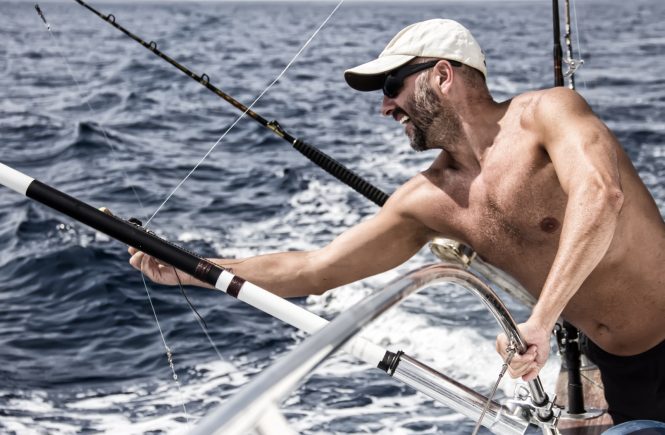You’ve got all of your accessories and are heading out for a day of fishing. Are you sure you have the right saltwater fishing line?
Think about it. It’s your fishing line that connects the lure or bait to your rod and reel. It’s paid out, thrown or cast, in the hopes that you’ll hook a fish.
Your line is critical to reeling it in. And you don’t want it to break.
That’s why it’s important to understand the differences in saltwater fishing lines.
What Should You Look For In A Saltwater Fishing Line?
First and foremost, you need to be sure you have the right strength line.
The strength of a fishing line is measured in pounds. It’s also known as test.
As a general rule, if you’re a new or slightly experienced angler, go with the lightest gear possible. You’ll have more fun and come back less exhausted.
The test should roughly match the weight of the species for which you are fishing. In other words, if you’re looking to hook a tuna in the 30-pound range, then you’ll want a line in the 30-pound test.
Once you’ve established the proper test, you can move on to determining which material is going to be best for you.
There Are Three Different Line Materials
They are as follows:
- Nylon Monofilament
- Fluorocarbon
- Braided
Monofilament line was first to market. And for a long time, it was the only material available. Then fluorocarbon came along offering more options.
It was with the introduction of braids that the selection expanded dramatically.
It should be noted though that braids aren’t necessarily better than monofilaments or fluorocarbons. Again, it depends on personal preference.
So let’s take look at the attributes of each of these materials.
1. Nylon Monofilament
One of the biggest advantages of the mono or copolymer lines is that they’re inexpensive. And a new nylon monofilament line casts well.
Monofilament – also known as mono – has an inherent stretch. Your knots will hold like a champ.
Another benefit of monofilament is its resistance to abrasion. If it gets wrapped up in an obstruction, you’re less likely to lose your catch.
With the mono line, it’s totally possible to get great value and great performance at the same time. You don’t have to sacrifice one for the other.
But there are a few drawbacks.
Over the long haul, monofilament takes the shape of the spool. This increases friction through the guides and could negatively affect your casting distance.
Plus, mono can dry out if it’s left in the sun for too long.
And while inherent stretch is great for knots, it’s not the best thing when the line is under strain. It may stretch too much.
An overstretched line can dampen and absorb light hits. And you may not always feel those hits.
The extra stretch is going to make it more challenging in situations where you need to turn a fish from obstructions too.
The good news is that monofilaments continue to improve. They’re becoming even more abrasion resistant and less prone to stretch.
The Breakdown on Monofilaments:
- Monofilament nylon is inexpensive, abrasion resistant, knots well and has an inherent stretch.
- It does have a tendency to overstretch though and can take the shape of the spool.
- It does not have resistance to UV rays and could dry in the sun.
- It’s a good choice for new anglers who are developing their skill.
- Mono continues to make improvements.
2. Fluorocarbon
Fluorocarbon has a refractive index that’s similar to water. That’s a scientific way of saying that it’s nearly invisible when it’s in clear water.
This is an especially important benefit for surf casters and fly rodders because fish tend to be fussy in clear waters.
Like mono, fluorocarbon is very abrasion resistant. This makes it a great choice for certain cover and structure fishing situations too.
It also has a quick sink rate.
Unlike mono, it has minimal spool memory and reduced stretch. Plus, it’s resistant to UV rays so it won’t dry out like mono.
The Breakdown on Fluorocarbon:
- Fluorocarbon has a quick sink rate, minimal spool memory, reduced stretch and great abrasion resistance.
- Its tolerance of UV rays provide for increased longevity.
- The line looks nearly invisible in water, making it ideal for surf casters and fly rodders.
3. Braids
There are two different kinds of braids. There are the first generation microfiber lines (six carrier braids) and the next generation lines (eight carrier braids).
First Generation Saltwater Fishing Line – Six Carrier Braids
Braided lines are constructed of a braid of synthetic materials woven into a rope. Each braided line has its own unique attributes.
The first generation of braids wove together six carrier products to create the line.
These lines are much thinner than monofilament and fluorocarbon lines that have the same strength. They are also more supple which helps to improve casting distance.
Unlike mono and fluorocarbons, braids have almost no stretch. This minimal line-stretch gives anglers increased sensitivity and the ability to feel hits.
It also means solid force transfer and maximum hook-setting power when playing a fish.
Next Generation Super Saltwater Fishing Line – Eight Carrier Braids
As the next generation of braided lines came on the market, manufacturers increased the number of fibers in the braid from six carrier products to eight.
The result was stronger, even thinner and smoother lines.
This, in turn, allows for improved casting distance, fewer wind knots and more line capacity in comparison to the first generation braids.
Breakdown on BOTH Generations of Braided Lines:
- Braid lines are thinner and offer terrific knot strength.
- They are inherently slippery though so familiar knots you may be in the habit of using could slip when tied with braid.
- Braids are mixed in abrasion resistance. In scenarios around rocks, monofilament will still have the edge.
- The “no stretch” quality of braids permits for better sensitivity and connection to the lure.
- Slick and supple braids will provide improved casting distance and greater line capacity.
So that’s the low-down on each saltwater fishing line.
If you’re still not sure which to choose, err on the strong side. Otherwise, you may lose your catch. And that’s a sad way to end your day on the water.
Please let us know if you have any other tips for picking the best saltwater fishing line by commenting below. We’d love to hear from you.


1 comment
What a excellent post! I spend a couple of moments on reading,
and I’m so excited about the advice I received.
It’s actually hard to find something precious on that topic.
However, this author seems to be a real professional because there is a
exceptional personality in his writings. I’m likely to sign up for his brand new publications, simply not to skip anything.
This informative article worths its reading.